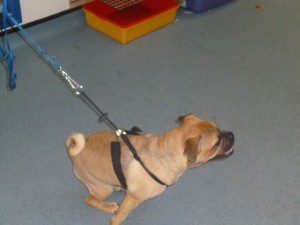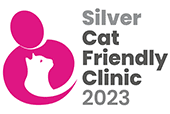 Ethel first came to see us as a puppy for her free puppy check. She was very lively and an adorable little pup, who seemed very healthy and full of beans! Ethel’s mum, soon noticed she seemed to be urinating frequently and not quite herself and a urine sample diagnosed a urinary tract infection. She improved initially with antibiotics but her mum was sure she wasn’t right. However, when Kim saw her, she seemed so lively and was growing well, it was like nothing was wrong at all. But 24 hours later, she came back and this time, the lively puppy we knew was quiet and not very active. Blood tests revealed a liver abnormality and, due to her age, it was suspected she had a portosystemic or liver shunt.
Ethel first came to see us as a puppy for her free puppy check. She was very lively and an adorable little pup, who seemed very healthy and full of beans! Ethel’s mum, soon noticed she seemed to be urinating frequently and not quite herself and a urine sample diagnosed a urinary tract infection. She improved initially with antibiotics but her mum was sure she wasn’t right. However, when Kim saw her, she seemed so lively and was growing well, it was like nothing was wrong at all. But 24 hours later, she came back and this time, the lively puppy we knew was quiet and not very active. Blood tests revealed a liver abnormality and, due to her age, it was suspected she had a portosystemic or liver shunt.
This is where the blood vessels that should carry nutrients from the intestines to the liver for processing are not properly formed and often results in high levels of unprocessed protein reaching the brain. This can cause head pressing (usually walking head first into an object and pushing against it) and even seizures. Due to the inability to process the nutrients properly, puppies often appear very stunted in growth and often lack energy. They also drink and urinate excessively, with very dilute urine making them more likely to get a urinary tract infection. Some dogs present when they are older with a particular type of bladder stone due to the inappropriate way they process protein, which is then filtered in to the urine through the kidneys.
Apparently, Ethel had not read the text book and so she didn’t show these signs at all! It was only her mum’s knowledge of her puppy that led us to run the blood tests and the result was completely unexpected.
She was referred to a specialist who confirmed the diagnosis, but said that the blood vessels had such a rare and abnormal pattern that surgery to correct the defect would not be possible. Usually, the blood vessel bypassing the liver is closed encouraging the smaller vessels going to the liver to get larger and perform the role of those that should have been there in the first place – transporting food nutrients from the bowel to the liver for processing into energy and the body’s building blocks.
Instead, Ethel would have to remain on lifelong medication – antibiotics to reduce excessive bacterial growth in the gut, a drug to reduce unprocessed proteins getting to the brain and an anti-convulsant to prevent the potential seizures and other neurological signs. A diet low in protein but containing high quality protein is also required to reduce the pressure on the liver. In some patients, this is the most appropriate course of action for the owner and dog and can give a good life expectancy, although it is often reduced.
Ethel’s mum naturally wanted the best for Ethel and scoured the internet, managing to locate a specialist surgeon from America who was working at the royal vet college at that time. Unfortunately for us, we can never know every specialist in every field but will always try to support owners that discover an avenue for treatment we were unaware of, when appropriate. We referred her there and she underwent her first surgery. The abnormal blood vessels couldn’t all be closed at once as their pattern was so abnormal it led to loss of blood supply to the intestines and spleen and would have killed Ethel if closed completely. Instead it had to be done in stages.
Ethel recovered well from her first surgery and recently underwent her second. Surgery is fraught with significant risks – the closed blood vessel can increase the blood pressure in the liver and affect its function and lead to potentially fatal seizures. There is also a risk of haemorrhage during the procedure amongst other risks. Thankfully, Ethel is an exceptionally strong little dog and we recently saw her after her second (and final) surgery. She has recovered exceptionally well (possibly too well, its difficult to stop her bouncing and no one has told her she is supposed to be recuperating)! She will no longer need her medication or her special diet and she can go on to live a normal life.
Shunts often have an inherited component and therefore these animals should not be bred from, although many breeders will be unaware that a particular mating will lead to this condition and there are other factors involved in creating shunts. Some may be acquired later in life due to blood pressure changes in the liver causing some blood vessels to essentially become blocked. Shunts are more commonly seen in dogs than cats.
Whether managed surgically or with medication, shunts can be very costly to treat, even when only one surgery is required. Thankfully for Ethel, she has a very doting and dedicated mum who is however extremely thankful that she took out insurance with Pet Plan as they covered £4,000 of the £8,000 cost for all the treatment.







